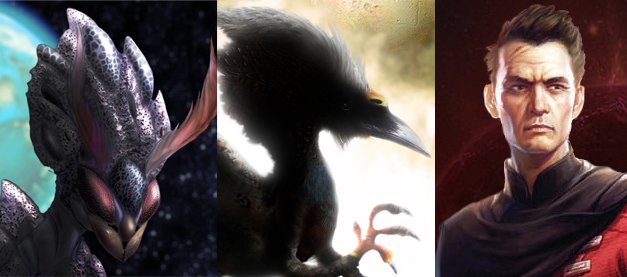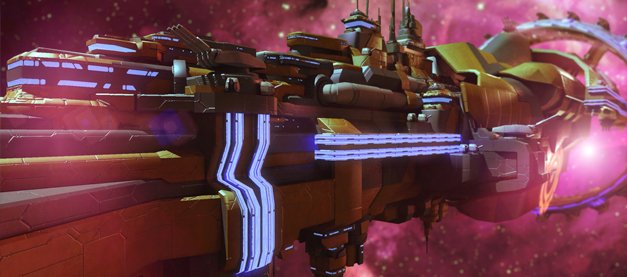
PC Gamer routinely features Developer Diaries: tales of what goes on behind-the-scenes in the development studios making your favorite games. In this entry, Sword of the Stars II: Lords of Winter's Lead Writer, Arinn Dembo, details the challenging and rewarding task of fashioning and maintaining the series' vast cosmic narrative. For more information, read the first , second , and third entries, and let us know what you'd like to see developers discuss in future diaries in the comments.
Sword of the Stars II developer diary 4: Encyclopedia of the Stars
I have been the Lead Writer for the Sword of the Stars franchise for seven years, and in that time I have created a fictional backdrop which spans two full games, two full expansions, a bonus ship pack and a published novel. I started the first game with four playable Races: the standard Humans were joined by the Tarka, a reptilian race, the Liir, a cetacean race, and the Hivers, who looked and acted a bit like eusocial insects, although they were a lot smarter and more dangerous than your average termite.
In each full expansion, I was able to introduce a new playable race. The Zuul, a pack of savage and rapacious scavengers, joined the game in Born of Blood. The Morrigi, a very ancient species of star-faring avian reptiles, descended on the universe in A Murder of Crows. Threaded throughout all four of the titles in the opening era of SotS was an overarching story about the "Lords of Winter"—a mystery faction absent from the present-day scene, but remembered by the Liir, Zuul and Morrigi for the atrocities it had committed while it was active in local space.

For seven years, in other words, the Lords of Winter have been a hidden mystery, waiting to be unlocked. For players who enjoyed the original game and its expansions, getting the chance to finally see and play the Lords is part of the overall experience. The ancient enemy has returned, just in time to crush or be crushed by the brash new upstarts who have boldly ventured forth into the stars.
Designing titans
To work this long on a single persistent universe has been quite a challenge, especially when the story I'm telling has to enfold at a genuinely cosmic scale. To create the "background fiction" for a space 4X (explore, expand, exploit, and exterminate) game, your characters are not individual people but gigantic empires, races and civilizations that have existed for thousands of years. These titans crash into one another on battlefield that spans the galaxy. They wrestle for control of a universe filled with danger and mystery.
Keep up to date with the most important stories and the best deals, as picked by the PC Gamer team.

While building and protecting new homes for their people, players encounter the colonies and fleets of neighboring empires, as well as the relics of past civilizations. These relics include ancient mining drones, abandoned and now run amok; races which transcended their carbon bodies and left all flesh behind; cosmic booby-traps set by races long extinct; and unspeakably ancient engines of war and peace which still roam the universe, long after the Elder Races who built them turned to dust.
A story told on such a massive scale makes even the standard epic look like pretty small potatoes. "Boy-meets-tyrant, boy-overthrows-government, boy-establishes-new-order" is great for a novel, a movie or even an RTS campaign, but it doesn't get the job done for a 4X game. Instead you have to tell the story of whole races and how they advance over time, not just technologically but politically and socially.
The little things
This "Big Picture" story is present in Sword of the Stars, but some players have always wanted more. After they've read the manual and played the game, an amazing number of people still come directly to the Kerberos forums to ask me questions about the little details. They want to know more about the races they're playing: their history, their art, their music, their religious beliefs. They want to know more about the technology they're researching. They want to know why AI's will always rebel if you push your research into Artificial Intelligence too hard and too fast. They want to find out the hidden stories behind the Grand Menaces and the minor nuisances they keep running into while exploring space.

One of the great things about working at Kerberos, of course, is that there is really no filter between the writer and the public. If people come to the Races forum and ask me a question about my work, I typically answer it right away. Over the years, this process of question and answer has produced a huge backlog of fictional tidbits. It makes the people who love immersive detail very happy! And fans of the game have worked very hard to incorporate this information into an on-line Wiki for the game and its expansions. The Wiki is one of the best resources available for new players, but of course, inevitably there are details missing.
Compiling the lore
One of my goals for Sword of the Stars II has been to place as much background information as possible at the player's fingertips, from the moment they first purchase the game. The Encyclopedia of the Stars—EoS for short—is one of the features I am working hardest to implement. When new players open the EoS for the first time, they will find basic entries on all of the races and factions of the game, as well as discussion pages for important gameplay features. Many pages will also unlock through play: new entries will appear the first time a new Technology has been researched, a new alien Menace in encountered, or when you meet new Independent Races for the first time.

Of course, all great books of lore have nice broad margins, where generations of readers can scribble their notes. Every page of the Encyclopedia will include a space for the player's "Marginalia," the jotted ideas and responses that come up along the way. These notes will be incorporated into a batch file which players will be able to exchange and upload, so that your personal version of the EoS can incorporate your own Marginalia, and the notes of two other players—whether these are your family and friends or some veteran/guru who has played the game so long and well that he's got All the Answers.
Naturally I know that there will always be more questions. I'll still be there on the Kerberos forums to answer them when I can, and the fan Wiki will always contain more insider information. In general, I'm hoping that new players will enjoy the Encyclopedia and that using it will help to catch them up to speed, not only on the background "Story of the Universe" but on the game's working features. The EoS will cover the old Races and the new Factions, but it will also give detailed information on many other topics: planets and their development; fleets, admirals and missions; domestic politics and diplomacy; trade and piracy; stations and support; ships and sections; research and technology; psionics and mechanics—and of course, the true nature of the Lords of Winter.
See you next time!
-Arinn Dembo
Lead Writer, Kerberos Productions
PC Gamer is the global authority on PC games—starting in 1993 with the magazine, and then in 2010 with this website you're currently reading. We have writers across the US, Canada, UK and Australia, who you can read about here.


